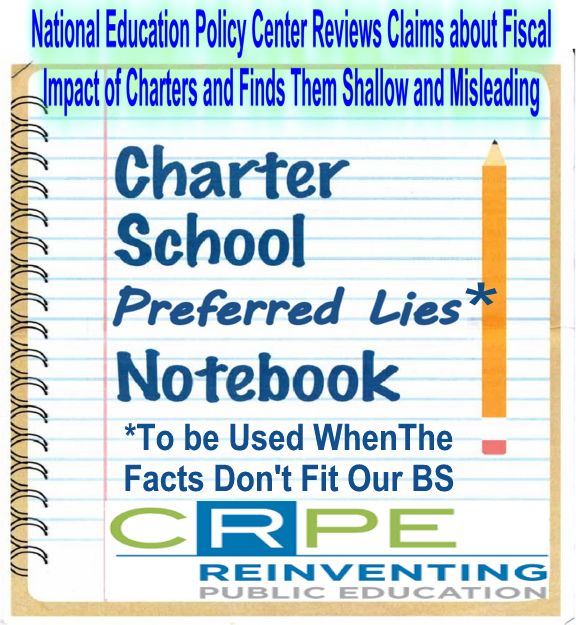National Education Policy Center Reviews Claims about Fiscal Impact of Charters and Finds Them Shallow and Misleading
Bruce Baker of Rutgers University reviewed three policy briefs produced by the pro-charter, pro-choice Center for Reinventing Public Education at the University of Washington and found them to be “generally superficial and misleading.” The apparent intent of these briefs was to influence the policy debate in California, in which Governor Newsom and the Legislature are considering whether to take into account the fiscal impact of charters on public schools. Baker’s review was sponsored by the National Education Policy Center at the University of Colorado.
Reviewed by Bruce D. Baker University of Colorado Boulder May 2019
Executive Summary
The Center on Reinventing Public Education (CRPE), based at the University of Washington, Bothell, recently released a series of three policy briefs on the financial impact of charter schools on nearby school districts in California. The briefs arrive at a time when a Task Force convened by California Gov. Gavin Newsom is deliberating on these exact matters. CRPE’s founder, Paul Hill, was a key source of testimony to the task force, serving as an expert viewed as “sympathetic to charter schools.”
The three briefs make note of the task force in their introduction and are seemingly intended to inform these ongoing debates over charter school financing and expansion in the state of California. The briefs are as follows.
- The first brief, Charter Schools and District Enrollment Loss, posits that charter school enrollment growth is not a significant factor in large district enrollment decline in California.
- The second brief, Do Charter Schools Cause Fiscal Distress in School Districts?, argues that charter school expansion is not a significant contributor to fiscal distress (fiscal stress and/or fiscal impact) in California school districts.
- The final brief, Do the Costs of California Charter Schools Outweigh the Benefits?, contends that there are “tangible benefits” and “few quantifiable costs” to charter schooling in California, though it does concede that a more thorough cost-benefit analysis is warranted.
The first brief acknowledges that over the long run, California charter school expansion has resulted in some district enrollment decline. But the brief contends that this decline has been modest and in recent years is no longer occurring. Further, the report asserts that whether charter schools expand or not, many districts will face continuing enrollment decline and “the financial challenges it brings” (p. 10).
The second brief lays out a set of figures showing charter school enrollment shares and comparing this to county-assigned classifications of district fiscal distress. It concludes boldly that (a) there is no relationship between charter enrollment share and host district fiscal distress; (b) instead, fiscal distress is most often caused by financial mismanagement; and (c) fiscal distress is too important to get wrong.
The third brief first asserts that there are benefits to, but few if any tangible costs associated with, charter schooling in California. Those benefits are illustrated by reports of differences in test score gains for children in some urban California charter schools versus matched peers in host districts. The brief also cites a handful of studies to support its contention that charter expansion also benefits, or at least does not harm, children in host district schools. Finally, it notes other potential benefits for children enrolled in charter schools, for which quantifiable values are more difficult to assign, including: “The option to choose” (p. 4).
On the potential-costs side of charter expansion, the third brief provides a short list, including, (a) lacking/losing economies of scale, (b) transfers/fiscal impact, (c) capital costs, (d) educating high-cost students, and (e) social cohesion and societal concerns. The authors then dismiss these five concerns, offering the conclusion that there are “few quantifiable costs to charter schooling” in California (p. 6). Yet they provide little analysis or reference to any valid, rigorous analysis by any other researchers.
Robin Lake, Ashley Jochim, Paul Hill, and Sivan Tuchman wrote these briefs and qualify their work with identical wording: “Given the time constraints for informing the commis- sion’s and legislator’s questions, we were limited to data available from earlier studies and from federal, state, and local databases, as cited in the three briefs” (p. 2 of each brief).
These limitations did impair the usefulness of the briefs, but other problems are also evi- dent. The first brief is misleading in its assertion that charter enrollment growth is not to blame for district enrollment decline. It is, and has been for some time, whether in districts with declining, stable or growing overall student enrollments. The brief also attempts to minimize the import of the considerable role played by charters in districts’ enrollment loss, offering up the non sequitur that enrollment loss can arise from other sources as well. The second brief relies on overly simplistic comparisons of charter enrollments and county-assigned “fiscal distress” classifications to conclude that there is no association between charter enrollments and fiscal distress. The contention here is that there can’t be an illness if the patient isn’t dead. In order to rely on this problematic approach, the brief erroneously dismisses a significant, more rigorous, detailed, peer-reviewed and published body of research that illustrates the fiscal impact of charter schools on host districts, and how those fiscal impacts may lead to fiscal stress. The third brief, which presents itself as an analysis of costs and benefits, merely touts the benefits of charter schooling as tangible while being entirely dismissive of numerous known and often measurable costs. Taken together, the briefs are useful only in pointing to some important issues that policymakers should consider; their analyses of those issues are, however, generally superficial and misleading.National Education Policy Center Reviews Claims about Fiscal Impact of Charters and Finds Them Shallow and Misleading | Diane Ravitch's blog
NEPC Review: California Charter Schools: Costs, Benefits, and Impact on School Districts (Center on Reinventing Public Education, May 2019) | National Education Policy Center - https://nepc.colorado.edu/node/9821 on @NEPCtweet



